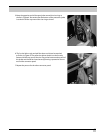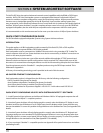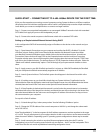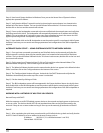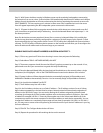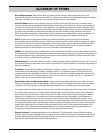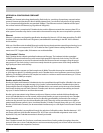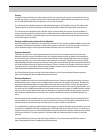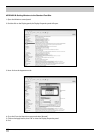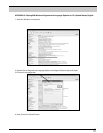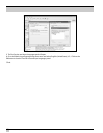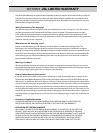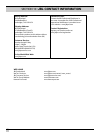
33
JBL Professional
Priority
A higher Conductor Priority over-rides a lower priority. If an operating Conductor is removed from the net-
work for any reason (e.g. power turned off), the remaining devices again arbitrate and select a new Conduc-
tor. All CobraNet devices have the capacity to serve as the Conductor.
The Conductor periodically broadcasts a well-defined message to all CobraNet™ devices. This allows each
CobraNet device to recover the master clock timing information needed for high quality audio delivery.
The Conductor also recognizes each CobraNet device on the network and assumes the responsibility to
assign transmitter positions and priorities for each Bundle of each CobraNet device. Like a conductor of an
orchestra, the Conductor signals the beginning of a synchronous transmission cycle, and then each device
sends its Bundle(s) in lock step.
Primary and Secondary Network Ports (Dualink)
Some CobraNet devices implement two network connections. This provides for added reliability in the event
of problems with network hardware or cabling. If the primary connection is lost, the secondary connection
can be enabled using an entirely separate network hardware path in less than a few seconds.
Repeater Networks
CobraNet can operate on simple repeater-based networks and more complex switch-based networks.
Repeater networks use low-cost Ethernet hubs. On a repeater-based network, all packets are broadcast to
all connected nodes. CobraNet multi-cast and unicast Bundles can be assigned but because of the simpler
repeater-type hubs, even unicast transmissions are broadcast to all nodes. Therefore, a maximum of 8 full-
loaded Bundles (64 audio channels) are allowed on the entire network. More Bundles may be allowed if they
are loaded with less than the full eight audio channels. There is no limit to the number of active receivers on
a repeater network. Generally, a repeater based CobraNet network must be dedicated to CobraNet traffic
only to guarantee reliable transmission of audio packets.
See Tested Ethernet Products on the Peak Audio website for a list of recommended Ethernet repeaters.
http://www.peakaudio.com/CobraNet/tested_Ethernet.html
Switched Networks
Larger CobraNet networks can be built using Ethernet switches. Ethernet switching technology is more so-
phisticated than hubs. Switches do not simply broadcast each and every packet to all nodes. Instead, they
examine the destination address of each packet received on each port, and then “switch” that data to the
identified recipient. CobraNet unicast Bundles exploit this feature to allow more overall network traffic. In ef-
fect each port has 100MB of bandwidth and the overall network can be as large as 100MB times the number
of ports on the network. Multicast Bundles are allowed on a switched network, but they must be used with
care. Peak recommends that not more than four multicast Bundles be used in a switched CobraNet net-
work.
Another enhancement available with most new Ethernet switches is “full-duplex” links. A full-duplex link al-
lows simultaneous send and receive over the same Ethernet connection. This enables a CobraNet device to
simultaneously send and receive up to 64 channels per node for a total of 128 channels.
The combination of switching and full-duplex technologies in switched CobraNet networks allows up to 128
channels per 100Mbit Ethernet link and greater than 3000 individual audio channels. There is no limit to the
number of active receivers on a switched CobraNet network. Switched networks also eliminate the potential
for Ethernet collisions. This allows general PC network traffic and CobraNet traffic to coexist on the same
network.
See Tested Ethernet Products on the Peak Audio website for a list of recommended Ethernet switches.
http://www.peakaudio.com/CobraNet/tested_Ethernet.html



